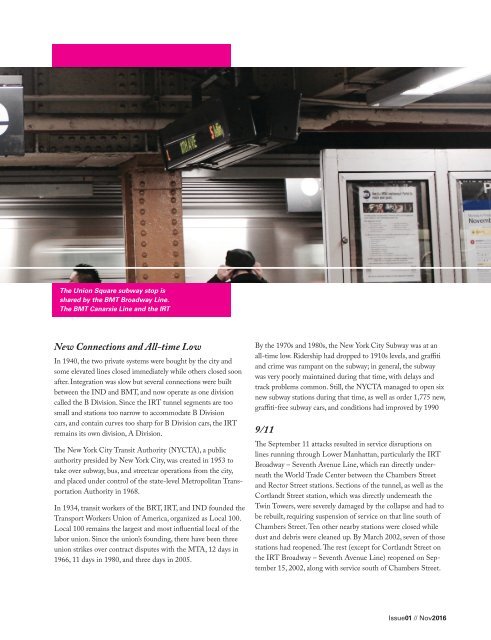Create successful ePaper yourself
Turn your PDF publications into a flip-book with our unique Google optimized e-Paper software.
The Union Square subway stop is<br />
shared by the BMT Broadway Line.<br />
The BMT Canarsie Line and the IRT<br />
New Connections and All-time Low<br />
In 1940, the two private systems were bought by the city and<br />
some elevated lines closed immediately while others closed soon<br />
after. Integration was slow but several connections were built<br />
between the IND and BMT, and now operate as one division<br />
called the B Division. Since the IRT tunnel segments are too<br />
small and stations too narrow to accommodate B Division<br />
cars, and contain curves too sharp for B Division cars, the IRT<br />
remains its own division, A Division.<br />
The New York City Transit Authority (NYCTA), a public<br />
authority presided by New York City, was created in 1953 to<br />
take over subway, bus, and streetcar operations from the city,<br />
and placed under control of the state-level Metropolitan Transportation<br />
Authority in 1968.<br />
In 1934, transit workers of the BRT, IRT, and IND founded the<br />
Transport Workers Union of America, organized as Local 100.<br />
Local 100 remains the largest and most influential local of the<br />
labor union. Since the union’s founding, there have been three<br />
union strikes over contract disputes with the MTA, 12 days in<br />
1966, 11 days in 1980, and three days in 2005.<br />
By the 1970s and 1980s, the New York City Subway was at an<br />
all-time low. Ridership had dropped to 1910s levels, and graffiti<br />
and crime was rampant on the subway; in general, the subway<br />
was very poorly maintained during that time, with delays and<br />
track problems common. Still, the NYCTA managed to open six<br />
new subway stations during that time, as well as order 1,775 new,<br />
graffiti-free subway cars, and conditions had improved by 1990<br />
9/11<br />
The September 11 attacks resulted in service disruptions on<br />
lines running through Lower Manhattan, particularly the IRT<br />
Broadway – Seventh Avenue Line, which ran directly underneath<br />
the World Trade Center between the Chambers Street<br />
and Rector Street stations. Sections of the tunnel, as well as the<br />
Cortlandt Street station, which was directly underneath the<br />
Twin Towers, were severely damaged by the collapse and had to<br />
be rebuilt, requiring suspension of service on that line south of<br />
Chambers Street. Ten other nearby stations were closed while<br />
dust and debris were cleaned up. By March 2002, seven of those<br />
stations had reopened. The rest (except for Cortlandt Street on<br />
the IRT Broadway – Seventh Avenue Line) reopened on September<br />
15, 2002, along with service south of Chambers Street.<br />
Issue01 // Nov2016


